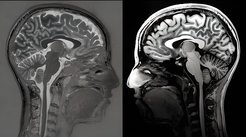MPRG MR Physics
The MR physics group at the Max Planck Institute for Human Development is working on the implementation of reproducible and robust MR physics methods, quantitative MRI, and the validating and usage of in-vivo histology using MRI (hMRI). Moreover, our group is also responsible for the operation of the local MRI imaging core facility. Our MR Physics group is located both here at the Max Planck Institute for Human Development and at the University Medical Centre Hamburg Eppendorf (UKE).

One primary research focus of our group is the development and validation of MR-based biophysical models to estimate specific microstructure tissue parameters such as the MR-based g-ratio (a measure of axonal conduction velocity), axon radii distribution, or myelin density using in vivo and ex vivo MRI as well as ex vivo histology. Moreover, we focus on minimising instrumental and physiological artefacts, particularly large in in vivo MRI, to enable high-quality studies with stable and reproducible estimation of quantitative MRI and valid hMRI parameters. This line of research is especially useful for studies that are significantly degraded by subject motion, e.g.: development and aging studies including children and patients or longitudinal study designs. Motion artefacts can in fact easily alter the measurement results and can be mistaken as the effect of interest. To acquire reliable quantitative MRI and valid hMRI parameters, we will combine image-based artefact detection and correction methods with advanced image reconstruction methods.
The MPI for Human Development is equipped with a 3T-Tim-Trio Siemens MR system and we are currently procuring two new cutting-edge MR systems, one 7T and one 3T human MR system.
Are you interested in working with us?
Stay tuned! The ERC project “MRStain - Nicht-invasive Färbung der Gewebemikrostruktur bei Temporallappenepilepsie unter Verwendung von In-vivo-MRT” will start in 2024 and several PhD and postdocs positions will soon be available.
